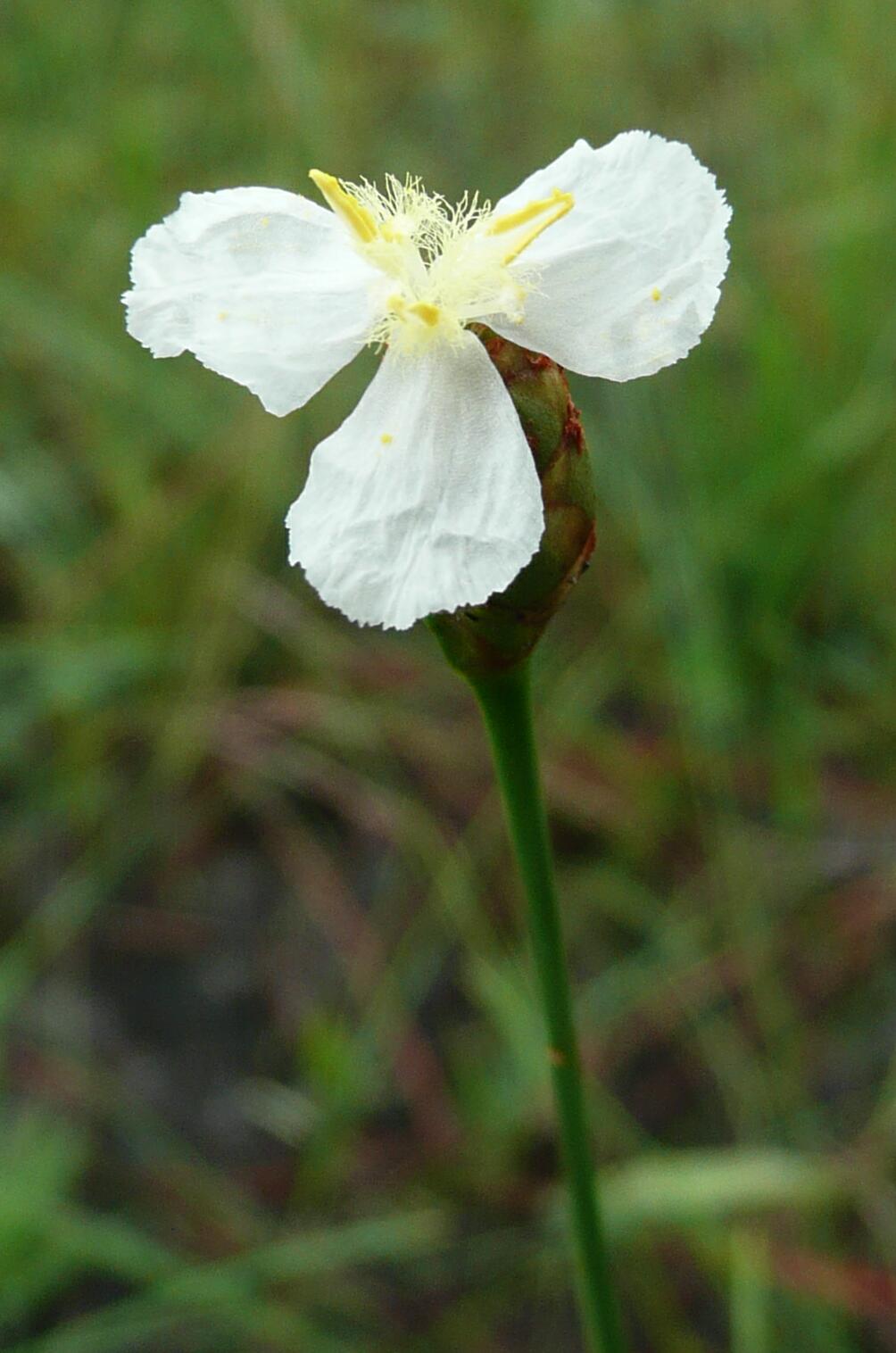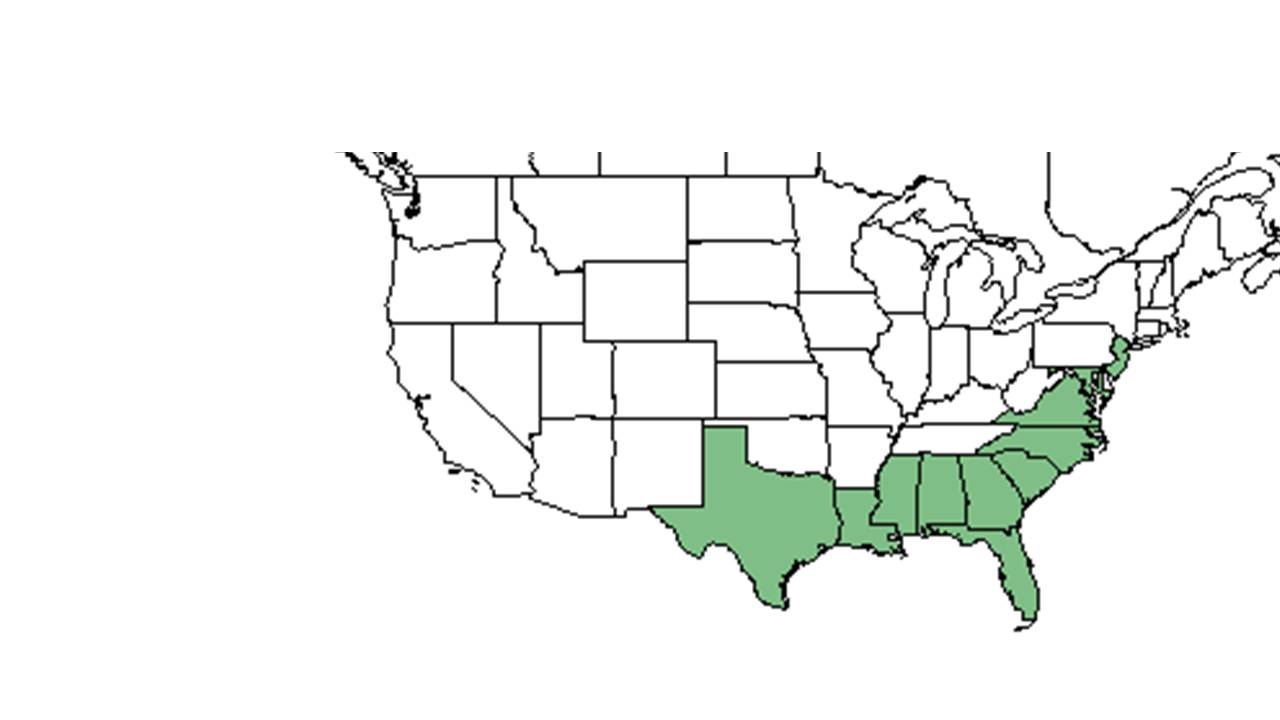Xyris caroliniana
| Xyris caroliniana | |
|---|---|

| |
| Xyris caroliniana, the Peninsular Florida white-flowered form | |
| Scientific classification | |
| Kingdom: | Plantae |
| Division: | Magnoliophyta – Flowering plants |
| Class: | Liliopsida – Monocotyledons |
| Order: | Commelinales |
| Family: | Xyridaceae |
| Genus: | Xyris |
| Species: | X. caroliniana |
| Binomial name | |
| Xyris caroliniana Walter | |

| |
| Natural range of Xyris caroliniana from USDA NRCS Plants Database. | |
Common names: Carolina yellow-eyed grass, Pineland yellow-eyed grass
Contents
Taxonomic notes
Synonyms: X. flexuosa Muhlenberg ex Elliott; X. pallescens (C. Mohr) Small.[1]
Description
A description of Xyris caroliniana is provided in The Flora of North America.
Distribution
Xyris caroliniana is common in the moist sands of pine flatwoods or savannas, well-drained sands or moist depressions of mesic to scrubby flatwoods, sandhills, and scrub throughout Florida and the Coastal Plain regions of the eastern United States[2] with disjunct populations in western Cuba.[3]
Ecology
Habitat
In the Coastal Plain in Florida and Georgia, X. caroliniana has been found in mesic sandy meadows; seepage slopes with Rhynchospora; sandy loam of burned wiregrass-longleaf pinewoods; sandy peat of pine-palmetto flatwoods; sand of open slash pine woodland bordering Hypericum marshes; oak scrub at margin of pine flatwoods; wiregrass-palmetto-slash pine plantation; sandy peat of flatwoods bog; upper edge of grass-sedge bog; wet pine flatwoods; mixed hardwood/cabbage palm hammocks; sandy peat of hillside bogs; mixed pine-oak woodlands; dry boggy areas near small stands of cypress; sandy dune hallows; sandy loam at edge of Ilex myrtifolia depression swamp; turkey oak/longleaf pine barrens; and in sand around ephemeral ponds.[4][5] In disturbed habitats this species has been found in roadside ditches; semi-disturbed remnant of longleaf pine-saw palmetto flatwoods; borrow pit bog; and in sandy peat of drained and bulldozed flatwoods bog.[2]
Xyris caroliniana is frequent and abundant in the North Florida Mesic Flatwoods, Central Florida Flatwoods/Prairies, and Upper Panhandle Savannas community types as described in Carr et al. (2010).[6]
Substrate types include sandy loam, sand, sandy peat, and fine sand.[4] Associated species include Rhynchospora, Hypericum, Fuirena scirpoidea, Fimbristylis caroliniana, Juncus scirpoides, Rhexia cubensis, Seymeria, Aristida stricta, Conradina, Ilex, Lyonia, Xyris elliottii, Ilex myrtifolia, Serenoa repens, Mitreola petiolata, Xyris flexuosa, Sabatia brevifolia, Kalmia hirsuta, Balduina uniflora, Polygala lutea, Sorghastrum secundum, Quercus pumila, Liatris graminifolia, and Helianthus heterophyllus.[4]
Phenology
X. caroliniana has been observed flowering in February, May through October and fruiting June through October.[4][7]
Conservation, cultivation, and restoration
Cultural use
Photo Gallery
References and notes
- ↑ Weakley, A.S. 2015. Flora of the southern and mid-atlantic states. Working Draf of 21 May 2015. University of North Carolina at Chapel Hill, Chapel Hill, North Carolina.
- ↑ 2.0 2.1 Cite error: Invalid
<ref>tag; no text was provided for refs namedEB - ↑ Sorrie, B. A. and A. S. Weakley 2001. Coastal Plain valcular plant endemics: Phytogeographic patterns. Castanea 66: 50-82.
- ↑ 4.0 4.1 4.2 4.3 Florida State University Robert K. Godfrey Herbarium database. URL: http://herbarium.bio.fsu.edu. Last accessed: July 2015. Collectors: Karen MacClendon, B. Boothe, Loran C. Anderson, Robert Kral, Loran C. Anderson, James R. Burkhalter, F. R. Hedges, W. P. Adams, Allen G. Shuey, Cecil R Slaughter, P. L. Redfearn, J. P. Gillespie, D. L. Fichtner, Sidney McDaniel, R. F. Throne, R. A. Davidson, William Reese, Bian Tan, Steve L. Orzell, Edwin L. Bridges, N. C. Henderson, Bruce Hansen, JoAnn Hansen, George R. Cooley, R. J. Eaton, Olga Lakela, M. Davis, R. A. Norris, Annie Schmidt. States and Counties: Florida: Alachua, Bay, Brevard, Calhoun, Charlotte, Citrus, Clay, Collier, DeSoto, Escambia, Franklin, Gadsden, Gulf, Hernando, Indian River, Jackson, Jefferson, Leon, Levy, Liberty, Martin, Okaloosa, Orange, Pasco, Santa Rosa, Seminole, St. Lucie, Sumter, Volusia, Wakulla, Walton, Washington. Georgia: Thomas. Compiled by Tall Timbers Research Station and Land Conservancy.
- ↑ Glitzenstein, J. S., D. R. Streng, et al. (2003). "Fire frequency effects on longleaf pine (Pinus palustris, P.Miller) vegetation in South Carolina and northeast Florida, USA." Natural Areas Journal 23: 22-37.
- ↑ Carr, S.C., K.M. Robertson, and R.K. Peet. 2010. A vegetation classification of fire-dependent pinelands of Florida. Castanea 75:153-189.
- ↑ Nelson, G. PanFlora: Plant data for the eastern United States with emphasis on the Southeastern Coastal Plains, Florida, and the Florida Panhandle. www.gilnelson.com/PanFlora/ Accessed: 15 DEC 2016